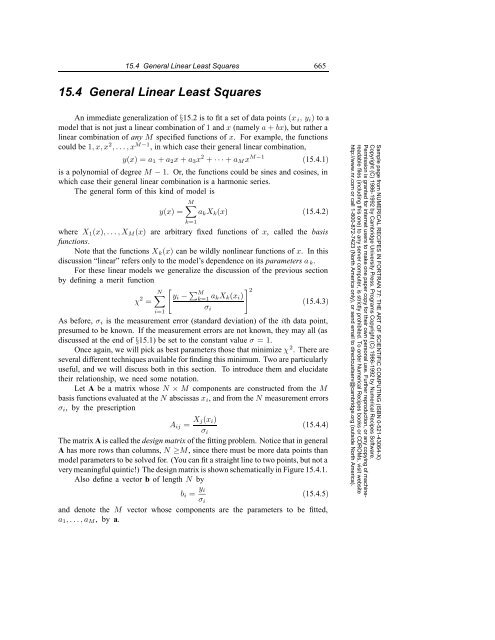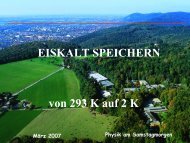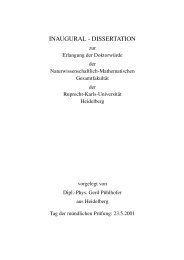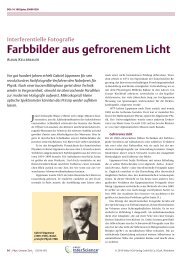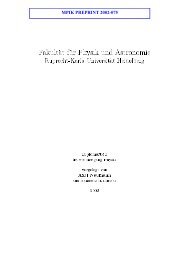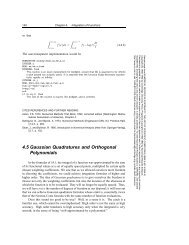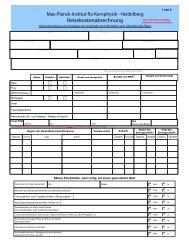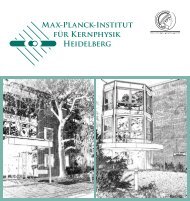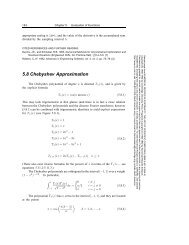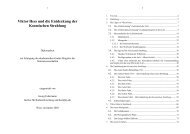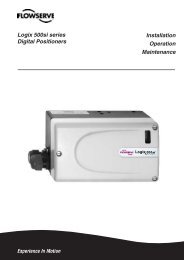15.4 General Linear Least Squares
15.4 General Linear Least Squares
15.4 General Linear Least Squares
You also want an ePaper? Increase the reach of your titles
YUMPU automatically turns print PDFs into web optimized ePapers that Google loves.
<strong>15.4</strong> <strong>General</strong> <strong>Linear</strong> <strong>Least</strong> <strong>Squares</strong> 665<br />
<strong>15.4</strong> <strong>General</strong> <strong>Linear</strong> <strong>Least</strong> <strong>Squares</strong><br />
An immediate generalization of §15.2 is to fit a set of data points (x i, yi) to a<br />
model that is not just a linear combination of 1 and x (namely a + bx), but rather a<br />
linear combination of any M specified functions of x. For example, the functions<br />
could be 1,x,x 2 ,...,x M−1 , in which case their general linear combination,<br />
(<strong>15.4</strong>.1)<br />
is a polynomial of degree M − 1. Or, the functions could be sines and cosines, in<br />
which case their general linear combination is a harmonic series.<br />
The general form of this kind of model is<br />
M<br />
y(x) = akXk(x) (<strong>15.4</strong>.2)<br />
y(x) =a1 + a2x + a3x 2 + ···+ aM x M−1<br />
i=1<br />
k=1<br />
where X1(x),...,XM(x) are arbitrary fixed functions of x, called the basis<br />
functions.<br />
Note that the functions Xk(x) can be wildly nonlinear functions of x. In this<br />
discussion “linear” refers only to the model’s dependence on its parameters a k.<br />
For these linear models we generalize the discussion of the previous section<br />
by defining a merit function<br />
χ 2 N<br />
<br />
yi −<br />
=<br />
M k=1 akXk(xi)<br />
2 (<strong>15.4</strong>.3)<br />
As before, σi is the measurement error (standard deviation) of the ith data point,<br />
presumed to be known. If the measurement errors are not known, they may all (as<br />
discussed at the end of §15.1) be set to the constant value σ =1.<br />
Once again, we will pick as best parameters those that minimize χ 2 . There are<br />
several different techniques available for finding this minimum. Two are particularly<br />
useful, and we will discuss both in this section. To introduce them and elucidate<br />
their relationship, we need some notation.<br />
Let A be a matrix whose N × M components are constructed from the M<br />
basis functions evaluated at the N abscissas xi, and from the N measurement errors<br />
σi, by the prescription<br />
Aij = Xj(xi)<br />
(<strong>15.4</strong>.4)<br />
The matrix A is called the design matrix of the fitting problem. Notice that in general<br />
A has more rows than columns, N ≥M, since there must be more data points than<br />
model parameters to be solved for. (You can fit a straight line to two points, but not a<br />
very meaningful quintic!) The design matrix is shown schematically in Figure <strong>15.4</strong>.1.<br />
Also define a vector b of length N by<br />
σi<br />
σi<br />
bi = yi<br />
σi<br />
(<strong>15.4</strong>.5)<br />
and denote the M vector whose components are the parameters to be fitted,<br />
a1,...,aM, by a.<br />
Sample page from NUMERICAL RECIPES IN FORTRAN 77: THE ART OF SCIENTIFIC COMPUTING (ISBN 0-521-43064-X)<br />
Copyright (C) 1986-1992 by Cambridge University Press. Programs Copyright (C) 1986-1992 by Numerical Recipes Software.<br />
Permission is granted for internet users to make one paper copy for their own personal use. Further reproduction, or any copying of machinereadable<br />
files (including this one) to any server computer, is strictly prohibited. To order Numerical Recipes books or CDROMs, visit website<br />
http://www.nr.com or call 1-800-872-7423 (North America only), or send email to directcustserv@cambridge.org (outside North America).
666 Chapter 15. Modeling of Data<br />
data points<br />
x1<br />
x2<br />
.<br />
xN<br />
X1( ) X2( ) . . . XM( )<br />
X1(x1)<br />
σ1<br />
X1(x2)<br />
σ2<br />
.<br />
.<br />
.<br />
X1(xN)<br />
σN<br />
basis functions<br />
X2(x1)<br />
σ1<br />
X2(x2)<br />
σ2<br />
X2(xN)<br />
σN<br />
. . . XM(x1)<br />
σ1<br />
. . . XM(x2)<br />
σ2<br />
.<br />
.<br />
.<br />
.<br />
.<br />
. . . XM(xN)<br />
σN<br />
Figure <strong>15.4</strong>.1. Design matrix for the least-squares fit of a linear combination of M basis functions to N<br />
data points. The matrix elements involve the basis functions evaluated at the values of the independent<br />
variable at which measurements are made, and the standard deviations of the measured dependent variable.<br />
The measured values of the dependent variable do not enter the design matrix.<br />
Solution by Use of the Normal Equations<br />
The minimum of (<strong>15.4</strong>.3) occurs where the derivative of χ 2 with respect to all<br />
M parameters ak vanishes. Specializing equation (15.1.7) to the case of the model<br />
(<strong>15.4</strong>.2), this condition yields the M equations<br />
⎡<br />
⎤<br />
N<br />
0=<br />
1<br />
M<br />
⎣yi − ajXj(xi) ⎦ Xk(xi) k =1,...,M (<strong>15.4</strong>.6)<br />
σ<br />
i=1<br />
2 i<br />
j=1<br />
Interchanging the order of summations, we can write (<strong>15.4</strong>.6) as the matrix equation<br />
where<br />
αkj =<br />
N<br />
i=1<br />
Xj(xi)Xk(xi)<br />
σ 2 i<br />
an M × M matrix, and<br />
βk =<br />
N<br />
i=1<br />
yiXk(xi)<br />
σ 2 i<br />
M<br />
j=1<br />
αkjaj = βk<br />
(<strong>15.4</strong>.7)<br />
or equivalently [α] =A T · A (<strong>15.4</strong>.8)<br />
or equivalently [β] =A T · b (<strong>15.4</strong>.9)<br />
Sample page from NUMERICAL RECIPES IN FORTRAN 77: THE ART OF SCIENTIFIC COMPUTING (ISBN 0-521-43064-X)<br />
Copyright (C) 1986-1992 by Cambridge University Press. Programs Copyright (C) 1986-1992 by Numerical Recipes Software.<br />
Permission is granted for internet users to make one paper copy for their own personal use. Further reproduction, or any copying of machinereadable<br />
files (including this one) to any server computer, is strictly prohibited. To order Numerical Recipes books or CDROMs, visit website<br />
http://www.nr.com or call 1-800-872-7423 (North America only), or send email to directcustserv@cambridge.org (outside North America).
<strong>15.4</strong> <strong>General</strong> <strong>Linear</strong> <strong>Least</strong> <strong>Squares</strong> 667<br />
a vector of length M.<br />
The equations (<strong>15.4</strong>.6) or (<strong>15.4</strong>.7) are called the normal equations of the leastsquares<br />
problem. They can be solved for the vector of parameters a by the standard<br />
methods of Chapter 2, notably LU decomposition and backsubstitution, Choleksy<br />
decomposition, or Gauss-Jordan elimination. In matrix form, the normal equations<br />
can be written as either<br />
[α] · a =[β] or as<br />
A T · A · a = A T · b (<strong>15.4</strong>.10)<br />
The inverse matrix Cjk ≡ [α] −1<br />
jk is closely related to the probable (or, more<br />
precisely, standard) uncertainties of the estimated parameters a. To estimate these<br />
uncertainties, consider that<br />
aj =<br />
M<br />
[α] −1<br />
k=1<br />
M<br />
jk βk = Cjk<br />
k=1<br />
N<br />
i=1<br />
yiXk(xi)<br />
σ2 <br />
i<br />
(<strong>15.4</strong>.11)<br />
and that the variance associated with the estimate aj can be found as in (15.2.7) from<br />
σ 2 (aj) =<br />
N<br />
i=1<br />
Note that αjk is independent of yi, so that<br />
Consequently, we find that<br />
σ 2 (aj) =<br />
M<br />
M ∂aj<br />
=<br />
∂yi<br />
M<br />
k=1 l=1<br />
CjkCjl<br />
σ 2 i<br />
∂aj<br />
∂yi<br />
2<br />
CjkXk(xi)/σ<br />
k=1<br />
2 i<br />
N<br />
i=1<br />
Xk(xi)Xl(xi)<br />
σ2 <br />
i<br />
(<strong>15.4</strong>.12)<br />
(<strong>15.4</strong>.13)<br />
(<strong>15.4</strong>.14)<br />
The final term in brackets is just the matrix [α]. Since this is the matrix inverse of<br />
[C], (<strong>15.4</strong>.14) reduces immediately to<br />
σ 2 (aj) =Cjj<br />
(<strong>15.4</strong>.15)<br />
In other words, the diagonal elements of [C] are the variances (squared<br />
uncertainties) of the fitted parameters a. It should not surprise you to learn that the<br />
off-diagonal elements Cjk are the covariances between aj and ak (cf. 15.2.10); but<br />
we shall defer discussion of these to §15.6.<br />
We will now give a routine that implements the above formulas for the general<br />
linear least-squares problem, by the method of normal equations. Since we wish to<br />
compute not only the solution vector a but also the covariance matrix [C], it is most<br />
convenient to use Gauss-Jordan elimination (routine gaussj of §2.1) to perform the<br />
linear algebra. The operation count, in this application, is no larger than that for LU<br />
decomposition. If you have no need for the covariance matrix, however, you can<br />
save a factor of 3 on the linear algebra by switching to LU decomposition, without<br />
Sample page from NUMERICAL RECIPES IN FORTRAN 77: THE ART OF SCIENTIFIC COMPUTING (ISBN 0-521-43064-X)<br />
Copyright (C) 1986-1992 by Cambridge University Press. Programs Copyright (C) 1986-1992 by Numerical Recipes Software.<br />
Permission is granted for internet users to make one paper copy for their own personal use. Further reproduction, or any copying of machinereadable<br />
files (including this one) to any server computer, is strictly prohibited. To order Numerical Recipes books or CDROMs, visit website<br />
http://www.nr.com or call 1-800-872-7423 (North America only), or send email to directcustserv@cambridge.org (outside North America).
668 Chapter 15. Modeling of Data<br />
computation of the matrix inverse. In theory, since A T · A is positive definite,<br />
Cholesky decomposition is the most efficient way to solve the normal equations.<br />
However, in practice most of the computing time is spent in looping over the data<br />
to form the equations, and Gauss-Jordan is quite adequate.<br />
We need to warn you that the solution of a least-squares problem directly from<br />
the normal equations is rather susceptible to roundoff error. An alternative, and<br />
preferred, technique involves QR decomposition (§2.10, §11.3, and §11.6) of the<br />
design matrix A. This is essentially what we did at the end of §15.2 for fitting data to<br />
a straight line, but without invoking all the machinery of QR to derive the necessary<br />
formulas. Later in this section, we will discuss other difficulties in the least-squares<br />
problem, for which the cure is singular value decomposition (SVD), of which we give<br />
an implementation. It turns out that SVD also fixes the roundoff problem, so it is our<br />
recommended technique for all but “easy” least-squares problems. It is for these easy<br />
problems that the following routine, which solves the normal equations, is intended.<br />
The routine below introduces one bookkeeping trick that is quite useful in<br />
practical work. Frequently it is a matter of “art” to decide which parameters a k<br />
in a model should be fit from the data set, and which should be held constant at<br />
fixed values, for example values predicted by a theory or measured in a previous<br />
experiment. One wants, therefore, to have a convenient means for “freezing”<br />
and “unfreezing” the parameters ak. In the following routine the total number of<br />
parameters ak is denoted ma (called M above). As input to the routine, you supply<br />
an array ia(1:ma), whose components are either zero or nonzero (e.g., 1). Zeros<br />
indicate that you want the corresponding elements of the parameter vector a(1:ma)<br />
to be held fixed at their input values. Nonzeros indicate parameters that should be<br />
fitted for. On output, any frozen parameters will have their variances, and all their<br />
covariances, set to zero in the covariance matrix.<br />
SUBROUTINE lfit(x,y,sig,ndat,a,ia,ma,covar,npc,chisq,funcs)<br />
INTEGER ma,ia(ma),npc,ndat,MMAX<br />
REAL chisq,a(ma),covar(npc,npc),sig(ndat),x(ndat),y(ndat)<br />
EXTERNAL funcs<br />
PARAMETER (MMAX=50) Set to the maximum number of coefficients ma.<br />
C USES covsrt,gaussj<br />
Given a set of data points x(1:ndat), y(1:ndat) with individual standard deviations<br />
sig(1:ndat), useχ2minimization to fit for some or all of the coefficients a(1:ma) of a<br />
function that depends linearly on a, y = <br />
i ai ×afunci(x). The input array ia(1:ma) indicates<br />
by nonzero entries those components of a that should be fitted for, and by zero entries<br />
those components that should be held fixed at their input values. The program returns values<br />
for a(1:ma), χ2 = chisq, and the covariance matrix covar(1:ma,1:ma). (Parameters<br />
held fixed will return zero covariances.) npc is the physical dimension of covar(npc,npc)<br />
in the calling routine. The user supplies a subroutine funcs(x,afunc,ma) that returns<br />
the ma basis functions evaluated at x = x in the array afunc.<br />
INTEGER i,j,k,l,m,mfit<br />
REAL sig2i,sum,wt,ym,afunc(MMAX),beta(MMAX)<br />
mfit=0<br />
do 11 j=1,ma<br />
if(ia(j).ne.0) mfit=mfit+1<br />
enddo 11<br />
if(mfit.eq.0) pause ’lfit: no parameters to be fitted’<br />
do 13 j=1,mfit Initialize the (symmetric) matrix.<br />
do 12 k=1,mfit<br />
covar(j,k)=0.<br />
enddo 12<br />
beta(j)=0.<br />
enddo 13<br />
Sample page from NUMERICAL RECIPES IN FORTRAN 77: THE ART OF SCIENTIFIC COMPUTING (ISBN 0-521-43064-X)<br />
Copyright (C) 1986-1992 by Cambridge University Press. Programs Copyright (C) 1986-1992 by Numerical Recipes Software.<br />
Permission is granted for internet users to make one paper copy for their own personal use. Further reproduction, or any copying of machinereadable<br />
files (including this one) to any server computer, is strictly prohibited. To order Numerical Recipes books or CDROMs, visit website<br />
http://www.nr.com or call 1-800-872-7423 (North America only), or send email to directcustserv@cambridge.org (outside North America).
<strong>15.4</strong> <strong>General</strong> <strong>Linear</strong> <strong>Least</strong> <strong>Squares</strong> 669<br />
do 17 i=1,ndat Loop over data to accumulate coefficients of the normal<br />
call funcs(x(i),afunc,ma)<br />
ym=y(i)<br />
equations.<br />
if(mfit.lt.ma) then Subtract off dependences on known pieces of the fitting<br />
do 14 j=1,ma<br />
function.<br />
if(ia(j).eq.0) ym=ym-a(j)*afunc(j)<br />
enddo 14<br />
endif<br />
sig2i=1./sig(i)**2<br />
j=0<br />
do 16 l=1,ma<br />
if (ia(l).ne.0) then<br />
j=j+1<br />
wt=afunc(l)*sig2i<br />
k=0<br />
do 15 m=1,l<br />
if (ia(m).ne.0) then<br />
k=k+1<br />
covar(j,k)=covar(j,k)+wt*afunc(m)<br />
endif<br />
enddo 15<br />
beta(j)=beta(j)+ym*wt<br />
endif<br />
enddo 16<br />
enddo 17<br />
do 19 j=2,mfit Fill in above the diagonal from symmetry.<br />
do 18 k=1,j-1<br />
covar(k,j)=covar(j,k)<br />
enddo 18<br />
enddo 19<br />
call gaussj(covar,mfit,npc,beta,1,1)<br />
j=0<br />
Matrix solution.<br />
do 21 l=1,ma<br />
if(ia(l).ne.0) then<br />
j=j+1<br />
a(l)=beta(j)<br />
endif<br />
enddo 21<br />
Partition solution to appropriate coefficients a.<br />
chisq=0. Evaluate χ2 of the fit.<br />
do 23 i=1,ndat<br />
call funcs(x(i),afunc,ma)<br />
sum=0.<br />
do 22 j=1,ma<br />
sum=sum+a(j)*afunc(j)<br />
enddo 22<br />
chisq=chisq+((y(i)-sum)/sig(i))**2<br />
enddo 23<br />
call covsrt(covar,npc,ma,ia,mfit) Sort covariance matrix to true order of fitting<br />
return<br />
END<br />
coefficients.<br />
That last call to a subroutine covsrt is only for the purpose of spreading<br />
the covariances back into the full ma × ma covariance matrix, in the proper rows<br />
and columns and with zero variances and covariances set for variables which were<br />
held frozen.<br />
The subroutine covsrt is as follows.<br />
SUBROUTINE covsrt(covar,npc,ma,ia,mfit)<br />
INTEGER ma,mfit,npc,ia(ma)<br />
REAL covar(npc,npc)<br />
Expand in storage the covariance matrix covar, so as to take into account parameters that<br />
are being held fixed. (For the latter, return zero covariances.)<br />
INTEGER i,j,k<br />
REAL swap<br />
Sample page from NUMERICAL RECIPES IN FORTRAN 77: THE ART OF SCIENTIFIC COMPUTING (ISBN 0-521-43064-X)<br />
Copyright (C) 1986-1992 by Cambridge University Press. Programs Copyright (C) 1986-1992 by Numerical Recipes Software.<br />
Permission is granted for internet users to make one paper copy for their own personal use. Further reproduction, or any copying of machinereadable<br />
files (including this one) to any server computer, is strictly prohibited. To order Numerical Recipes books or CDROMs, visit website<br />
http://www.nr.com or call 1-800-872-7423 (North America only), or send email to directcustserv@cambridge.org (outside North America).
670 Chapter 15. Modeling of Data<br />
do 12 i=mfit+1,ma<br />
do 11 j=1,i<br />
covar(i,j)=0.<br />
covar(j,i)=0.<br />
enddo 11<br />
enddo 12<br />
k=mfit<br />
do 15 j=ma,1,-1<br />
if(ia(j).ne.0)then<br />
do 13 i=1,ma<br />
swap=covar(i,k)<br />
covar(i,k)=covar(i,j)<br />
covar(i,j)=swap<br />
enddo 13<br />
do 14 i=1,ma<br />
swap=covar(k,i)<br />
covar(k,i)=covar(j,i)<br />
covar(j,i)=swap<br />
enddo 14<br />
k=k-1<br />
endif<br />
enddo 15<br />
return<br />
END<br />
Solution by Use of Singular Value Decomposition<br />
In some applications, the normal equations are perfectly adequate for linear<br />
least-squares problems. However, in many cases the normal equations are very close<br />
to singular. A zero pivot element may be encountered during the solution of the<br />
linear equations (e.g., in gaussj), in which case you get no solution at all. Or a<br />
very small pivot may occur, in which case you typically get fitted parameters a k<br />
with very large magnitudes that are delicately (and unstably) balanced to cancel out<br />
almost precisely when the fitted function is evaluated.<br />
Why does this commonly occur? The reason is that, more often than experimenters<br />
would like to admit, data do not clearly distinguish between two or more of<br />
the basis functions provided. If two such functions, or two different combinations<br />
of functions, happen to fit the data about equally well — or equally badly — then<br />
the matrix [α], unable to distinguish between them, neatly folds up its tent and<br />
becomes singular. There is a certain mathematical irony in the fact that least-squares<br />
problems are both overdetermined (number of data points greater than number of<br />
parameters) and underdetermined (ambiguous combinations of parameters exist);<br />
but that is how it frequently is. The ambiguities can be extremely hard to notice<br />
a priori in complicated problems.<br />
Enter singular value decomposition (SVD). This would be a good time for you<br />
to review the material in §2.6, which we will not repeat here. In the case of an<br />
overdetermined system, SVD produces a solution that is the best approximation in<br />
the least-squares sense, cf. equation (2.6.10). That is exactly what we want. In the<br />
case of an underdetermined system, SVD produces a solution whose values (for us,<br />
the ak’s) are smallest in the least-squares sense, cf. equation (2.6.8). That is also<br />
what we want: When some combination of basis functions is irrelevant to the fit, that<br />
combination will be driven down to a small, innocuous, value, rather than pushed<br />
up to delicately canceling infinities.<br />
Sample page from NUMERICAL RECIPES IN FORTRAN 77: THE ART OF SCIENTIFIC COMPUTING (ISBN 0-521-43064-X)<br />
Copyright (C) 1986-1992 by Cambridge University Press. Programs Copyright (C) 1986-1992 by Numerical Recipes Software.<br />
Permission is granted for internet users to make one paper copy for their own personal use. Further reproduction, or any copying of machinereadable<br />
files (including this one) to any server computer, is strictly prohibited. To order Numerical Recipes books or CDROMs, visit website<br />
http://www.nr.com or call 1-800-872-7423 (North America only), or send email to directcustserv@cambridge.org (outside North America).
<strong>15.4</strong> <strong>General</strong> <strong>Linear</strong> <strong>Least</strong> <strong>Squares</strong> 671<br />
In terms of the design matrix A (equation <strong>15.4</strong>.4) and the vector b (equation<br />
<strong>15.4</strong>.5), minimization of χ 2 in (<strong>15.4</strong>.3) can be written as<br />
find a that minimizes χ 2 = |A · a − b| 2<br />
(<strong>15.4</strong>.16)<br />
Comparing to equation (2.6.9), we see that this is precisely the problem that routines<br />
svdcmp and svbksb are designed to solve. The solution, which is given by equation<br />
(2.6.12), can be rewritten as follows: If U and V enter the SVD decomposition<br />
of A according to equation (2.6.1), as computed by svdcmp, then let the vectors<br />
U (i) i =1,...,M denote the columns of U (each one a vector of length N); and<br />
let the vectors V (i); i =1,...,M denote the columns of V (each one a vector<br />
of length M). Then the solution (2.6.12) of the least-squares problem (<strong>15.4</strong>.16)<br />
can be written as<br />
a =<br />
M<br />
<br />
U(i) · b<br />
i=1<br />
wi<br />
V (i)<br />
(<strong>15.4</strong>.17)<br />
where the wi are, as in §2.6, the singular values returned by svdcmp.<br />
Equation (<strong>15.4</strong>.17) says that the fitted parameters a are linear combinations of<br />
the columns of V, with coefficients obtained by forming dot products of the columns<br />
of U with the weighted data vector (<strong>15.4</strong>.5). Though it is beyond our scope to prove<br />
here, it turns out that the standard (loosely, “probable”) errors in the fitted parameters<br />
are also linear combinations of the columns of V. In fact, equation (<strong>15.4</strong>.17) can<br />
be written in a form displaying these errors as<br />
<br />
M <br />
U(i) · b<br />
a =<br />
i=1<br />
wi<br />
V (i)<br />
<br />
± 1<br />
V (1) ±···±<br />
w1<br />
1<br />
V (M)<br />
wM<br />
(<strong>15.4</strong>.18)<br />
Here each ± is followed by a standard deviation. The amazing fact is that,<br />
decomposed in this fashion, the standard deviations are all mutually independent<br />
(uncorrelated). Therefore they can be added together in root-mean-square fashion.<br />
What is going on is that the vectors V (i) are the principal axes of the error ellipsoid<br />
of the fitted parameters a (see §15.6).<br />
It follows that the variance in the estimate of a parameter a j is given by<br />
σ 2 (aj) =<br />
M 1<br />
w<br />
i=1<br />
2 [V (i)]<br />
i<br />
2 M<br />
2 Vji<br />
j =<br />
wi<br />
i=1<br />
(<strong>15.4</strong>.19)<br />
whose result should be identical with (<strong>15.4</strong>.14). As before, you should not be<br />
surprised at the formula for the covariances, here given without proof,<br />
Cov(aj,ak) =<br />
M<br />
i=1<br />
VjiVki<br />
w 2 i<br />
<br />
(<strong>15.4</strong>.20)<br />
We introduced this subsection by noting that the normal equations can fail<br />
by encountering a zero pivot. We have not yet, however, mentioned how SVD<br />
overcomes this problem. The answer is: If any singular value w i is zero, its<br />
Sample page from NUMERICAL RECIPES IN FORTRAN 77: THE ART OF SCIENTIFIC COMPUTING (ISBN 0-521-43064-X)<br />
Copyright (C) 1986-1992 by Cambridge University Press. Programs Copyright (C) 1986-1992 by Numerical Recipes Software.<br />
Permission is granted for internet users to make one paper copy for their own personal use. Further reproduction, or any copying of machinereadable<br />
files (including this one) to any server computer, is strictly prohibited. To order Numerical Recipes books or CDROMs, visit website<br />
http://www.nr.com or call 1-800-872-7423 (North America only), or send email to directcustserv@cambridge.org (outside North America).
672 Chapter 15. Modeling of Data<br />
reciprocal in equation (<strong>15.4</strong>.18) should be set to zero, not infinity. (Compare the<br />
discussion preceding equation 2.6.7.) This corresponds to adding to the fitted<br />
parameters a a zero multiple, rather than some random large multiple, of any linear<br />
combination of basis functions that are degenerate in the fit. It is a good thing to do!<br />
Moreover, if a singular value wi is nonzero but very small, you should also<br />
define its reciprocal to be zero, since its apparent value is probably an artifact of<br />
roundoff error, not a meaningful number. A plausible answer to the question “how<br />
small is small?” is to edit in this fashion all singular values whose ratio to the<br />
largest singular value is less than N times the machine precision ɛ. (You might<br />
argue for √ N, or a constant, instead of N as the multiple; that starts getting into<br />
hardware-dependent questions.)<br />
There is another reason for editing even additional singular values, ones large<br />
enough that roundoff error is not a question. Singular value decomposition allows<br />
you to identify linear combinations of variables that just happen not to contribute<br />
much to reducing the χ 2 of your data set. Editing these can sometimes reduce the<br />
probable error on your coefficients quite significantly, while increasing the minimum<br />
χ 2 only negligibly. We will learn more about identifying and treating such cases<br />
in §15.6. In the following routine, the point at which this kind of editing would<br />
occur is indicated.<br />
<strong>General</strong>ly speaking, we recommend that you always use SVD techniques instead<br />
of using the normal equations. SVD’s only significant disadvantage is that it requires<br />
an extra array of size N × M to store the whole design matrix. This storage<br />
is overwritten by the matrix U. Storage is also required for the M × M matrix<br />
V, but this is instead of the same-sized matrix for the coefficients of the normal<br />
equations. SVD can be significantly slower than solving the normal equations;<br />
however, its great advantage, that it (theoretically) cannot fail, more than makes up<br />
for the speed disadvantage.<br />
In the routine that follows, the matrices u,v and the vector w are input as working<br />
space. np and mp are their various physical dimensions. The logical dimensions of the<br />
problem are ndata data points by ma basis functions (and fitted parameters). If you<br />
care only about the values a of the fitted parameters, then u,v,w contain no useful<br />
information on output. If you want probable errors for the fitted parameters, read on.<br />
SUBROUTINE svdfit(x,y,sig,ndata,a,ma,u,v,w,mp,np,<br />
* chisq,funcs)<br />
INTEGER ma,mp,ndata,np,NMAX,MMAX<br />
REAL chisq,a(ma),sig(ndata),u(mp,np),v(np,np),w(np),<br />
* x(ndata),y(ndata),TOL<br />
EXTERNAL funcs<br />
PARAMETER (NMAX=1000,MMAX=50,TOL=1.e-5)<br />
NMAX is the maximum expected value of ndata; MMAX the maximum expected for ma; the<br />
default TOL value is appropriate for single precision and variables scaled to be of order unity.<br />
C USES svbksb,svdcmp<br />
Given a set of data points x(1:ndata),y(1:ndata) with individual standard deviations<br />
sig(1:ndata), useχ2minimization to determine the ma coefficients a of the fitting function<br />
y = <br />
i ai×afunci(x). Here we solve the fitting equations using singular value decomposition<br />
of the ndata by ma matrix, as in §2.6. Arrays u(1:mp,1:np),v(1:np,1:np),<br />
w(1:np) provide workspace on input; on output they define the singular value decomposition,<br />
and can be used to obtain the covariance matrix. mp,np are the physical dimensions<br />
of the matrices u,v,w, as indicated above. It is necessary that mp≥ndata, np ≥ ma. The<br />
program returns values for the ma fit parameters a, andχ2 , chisq. The user supplies a<br />
subroutine funcs(x,afunc,ma) that returns the ma basis functions evaluated at x = x<br />
in the array afunc.<br />
INTEGER i,j<br />
Sample page from NUMERICAL RECIPES IN FORTRAN 77: THE ART OF SCIENTIFIC COMPUTING (ISBN 0-521-43064-X)<br />
Copyright (C) 1986-1992 by Cambridge University Press. Programs Copyright (C) 1986-1992 by Numerical Recipes Software.<br />
Permission is granted for internet users to make one paper copy for their own personal use. Further reproduction, or any copying of machinereadable<br />
files (including this one) to any server computer, is strictly prohibited. To order Numerical Recipes books or CDROMs, visit website<br />
http://www.nr.com or call 1-800-872-7423 (North America only), or send email to directcustserv@cambridge.org (outside North America).
<strong>15.4</strong> <strong>General</strong> <strong>Linear</strong> <strong>Least</strong> <strong>Squares</strong> 673<br />
REAL sum,thresh,tmp,wmax,afunc(MMAX),b(NMAX)<br />
do 12 i=1,ndata Accumulate coefficients of the fitting ma-<br />
call funcs(x(i),afunc,ma)<br />
tmp=1./sig(i)<br />
trix.<br />
do 11 j=1,ma<br />
u(i,j)=afunc(j)*tmp<br />
enddo 11<br />
b(i)=y(i)*tmp<br />
enddo 12<br />
call svdcmp(u,ndata,ma,mp,np,w,v) Singular value decomposition.<br />
wmax=0. Edit the singular values, given TOL from the<br />
do 13 j=1,ma<br />
if(w(j).gt.wmax)wmax=w(j)<br />
parameter statement, between here ...<br />
enddo 13<br />
thresh=TOL*wmax<br />
do 14 j=1,ma<br />
if(w(j).lt.thresh)w(j)=0.<br />
enddo 14<br />
call svbksb(u,w,v,ndata,ma,mp,np,b,a)<br />
...and here.<br />
chisq=0. Evaluate chi-square.<br />
do 16 i=1,ndata<br />
call funcs(x(i),afunc,ma)<br />
sum=0.<br />
do 15 j=1,ma<br />
sum=sum+a(j)*afunc(j)<br />
enddo 15<br />
chisq=chisq+((y(i)-sum)/sig(i))**2<br />
enddo 16<br />
return<br />
END<br />
Feeding the matrix v and vector w output by the above program into the<br />
following short routine, you easily obtain variances and covariances of the fitted<br />
parameters a. The square roots of the variances are the standard deviations of<br />
the fitted parameters. The routine straightforwardly implements equation (<strong>15.4</strong>.20)<br />
above, with the convention that singular values equal to zero are recognized as<br />
having been edited out of the fit.<br />
SUBROUTINE svdvar(v,ma,np,w,cvm,ncvm)<br />
INTEGER ma,ncvm,np,MMAX<br />
REAL cvm(ncvm,ncvm),v(np,np),w(np)<br />
PARAMETER (MMAX=20) Set to the maximum number of fit parameters.<br />
To evaluate the covariance matrix cvm of the fit for ma parameters obtained by svdfit,<br />
call this routine with matrices v,w as returned from svdfit. np,ncvm give the physical<br />
dimensions of v,w,cvm as indicated.<br />
INTEGER i,j,k<br />
REAL sum,wti(MMAX)<br />
do 11 i=1,ma<br />
wti(i)=0.<br />
if(w(i).ne.0.) wti(i)=1./(w(i)*w(i))<br />
enddo 11<br />
do 14 i=1,ma Sum contributions to covariance matrix (<strong>15.4</strong>.20).<br />
do 13 j=1,i<br />
sum=0.<br />
do 12 k=1,ma<br />
sum=sum+v(i,k)*v(j,k)*wti(k)<br />
enddo 12<br />
cvm(i,j)=sum<br />
cvm(j,i)=sum<br />
enddo 13<br />
enddo 14<br />
return<br />
END<br />
Sample page from NUMERICAL RECIPES IN FORTRAN 77: THE ART OF SCIENTIFIC COMPUTING (ISBN 0-521-43064-X)<br />
Copyright (C) 1986-1992 by Cambridge University Press. Programs Copyright (C) 1986-1992 by Numerical Recipes Software.<br />
Permission is granted for internet users to make one paper copy for their own personal use. Further reproduction, or any copying of machinereadable<br />
files (including this one) to any server computer, is strictly prohibited. To order Numerical Recipes books or CDROMs, visit website<br />
http://www.nr.com or call 1-800-872-7423 (North America only), or send email to directcustserv@cambridge.org (outside North America).
674 Chapter 15. Modeling of Data<br />
Examples<br />
Be aware that some apparently nonlinear problems can be expressed so that<br />
they are linear. For example, an exponential model with two parameters a and b,<br />
can be rewritten as<br />
y(x) =a exp(−bx) (<strong>15.4</strong>.21)<br />
log[y(x)] = c − bx (<strong>15.4</strong>.22)<br />
which is linear in its parameters c and b. (Of course you must be aware that such<br />
transformations do not exactly take Gaussian errors into Gaussian errors.)<br />
Also watch out for “non-parameters,” as in<br />
y(x) =a exp(−bx + d) (<strong>15.4</strong>.23)<br />
Here the parameters a and d are, in fact, indistinguishable. This is a good example of<br />
where the normal equations will be exactly singular, and where SVD will find a zero<br />
singular value. SVD will then make a “least-squares” choice for setting a balance<br />
between a and d (or, rather, their equivalents in the linear model derived by taking<br />
the logarithms). However — and this is true whenever SVD returns a zero singular<br />
value — you are better advised to figure out analytically where the degeneracy is<br />
among your basis functions, and then make appropriate deletions in the basis set.<br />
Here are two examples for user-supplied routines funcs. The first one is trivial<br />
and fits a general polynomial to a set of data:<br />
SUBROUTINE fpoly(x,p,np)<br />
INTEGER np<br />
REAL x,p(np)<br />
Fitting routine for a polynomial of degree np-1, with np coefficients.<br />
INTEGER j<br />
p(1)=1.<br />
do 11 j=2,np<br />
p(j)=p(j-1)*x<br />
enddo 11<br />
return<br />
END<br />
The second example is slightly less trivial. It is used to fit Legendre polynomials<br />
up to some order nl-1 through a data set.<br />
SUBROUTINE fleg(x,pl,nl)<br />
INTEGER nl<br />
REAL x,pl(nl)<br />
Fitting routine for an expansion with nl Legendre polynomials pl, evaluated using the<br />
recurrence relation as in §5.5.<br />
INTEGER j<br />
REAL d,f1,f2,twox<br />
pl(1)=1.<br />
pl(2)=x<br />
if(nl.gt.2) then<br />
twox=2.*x<br />
f2=x<br />
d=1.<br />
Sample page from NUMERICAL RECIPES IN FORTRAN 77: THE ART OF SCIENTIFIC COMPUTING (ISBN 0-521-43064-X)<br />
Copyright (C) 1986-1992 by Cambridge University Press. Programs Copyright (C) 1986-1992 by Numerical Recipes Software.<br />
Permission is granted for internet users to make one paper copy for their own personal use. Further reproduction, or any copying of machinereadable<br />
files (including this one) to any server computer, is strictly prohibited. To order Numerical Recipes books or CDROMs, visit website<br />
http://www.nr.com or call 1-800-872-7423 (North America only), or send email to directcustserv@cambridge.org (outside North America).
do 11 j=3,nl<br />
f1=d<br />
f2=f2+twox<br />
d=d+1.<br />
pl(j)=(f2*pl(j-1)-f1*pl(j-2))/d<br />
enddo 11<br />
endif<br />
return<br />
END<br />
Multidimensional Fits<br />
15.5 Nonlinear Models 675<br />
If you are measuring a single variable y as a function of more than one variable<br />
— say, a vector of variables x, then your basis functions will be functions of a vector,<br />
X1(x),...,XM(x). The χ 2 merit function is now<br />
χ 2 =<br />
N<br />
i=1<br />
<br />
yi − M<br />
k=1 akXk(xi)<br />
σi<br />
2<br />
(<strong>15.4</strong>.24)<br />
All of the preceding discussion goes through unchanged, with x replaced by x. In<br />
fact, if you are willing to tolerate a bit of programming hack, you can use the above<br />
programs without any modification: In both lfit and svdfit, the only use made<br />
of the array elements x(i) is that each element is in turn passed to the user-supplied<br />
routine funcs, which duly returns the values of the basis functions at that point. If<br />
you set x(i)=i before calling lfit or svdfit, and independently provide funcs<br />
with the true vector values of your data points (e.g., in a COMMON block), then funcs<br />
can translate from the fictitious x(i)’s to the actual data points before doing its work.<br />
CITED REFERENCES AND FURTHER READING:<br />
Bevington, P.R. 1969, Data Reduction and Error Analysis for the Physical Sciences (New York:<br />
McGraw-Hill), Chapters 8–9.<br />
Lawson, C.L., and Hanson, R. 1974, Solving <strong>Least</strong> <strong>Squares</strong> Problems (Englewood Cliffs, NJ:<br />
Prentice-Hall).<br />
Forsythe, G.E., Malcolm, M.A., and Moler, C.B. 1977, Computer Methods for Mathematical<br />
Computations (Englewood Cliffs, NJ: Prentice-Hall), Chapter 9.<br />
15.5 Nonlinear Models<br />
We now consider fitting when the model depends nonlinearly on the set of M<br />
unknown parameters ak,k =1, 2,...,M. We use the same approach as in previous<br />
sections, namely to define a χ 2 merit function and determine best-fit parameters<br />
by its minimization. With nonlinear dependences, however, the minimization must<br />
proceed iteratively. Given trial values for the parameters, we develop a procedure<br />
that improves the trial solution. The procedure is then repeated until χ 2 stops (or<br />
effectively stops) decreasing.<br />
Sample page from NUMERICAL RECIPES IN FORTRAN 77: THE ART OF SCIENTIFIC COMPUTING (ISBN 0-521-43064-X)<br />
Copyright (C) 1986-1992 by Cambridge University Press. Programs Copyright (C) 1986-1992 by Numerical Recipes Software.<br />
Permission is granted for internet users to make one paper copy for their own personal use. Further reproduction, or any copying of machinereadable<br />
files (including this one) to any server computer, is strictly prohibited. To order Numerical Recipes books or CDROMs, visit website<br />
http://www.nr.com or call 1-800-872-7423 (North America only), or send email to directcustserv@cambridge.org (outside North America).


